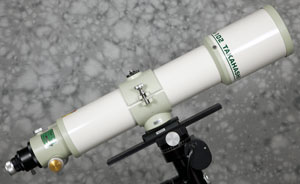 |
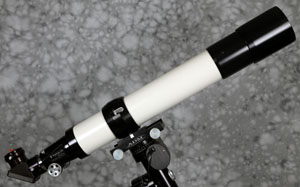 |
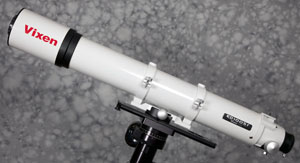 |
Takahashi TSA-102S |
Tele Vue 102 |
Vixen ED100SF |
The following tests were run to find a grab and go 4 inch refractor that would satisfy my needs for a good quality 4 inch refractor that could be mounted on an easily transported tripod or GM-8 mount and provide good views of the planets. I tested an entry level 100mm apocromat (Vixen ED100SF), a mid-level doublet (TV-102) and premium triplet (TSA-102) to see how well-built (and expensive) a 4-inch refractor I needed to see the planetary detail I was interested in viewing with an easily portable refractor and mount.
Refractors Used for Evaluations
All telescopes were purchased used on Astromart for the tests. They were in very good to near mint cosmetic condition and were evaluated to be mechanically and optically 100% functional with no defects in the front elements other than a little dust on the surface.
 |
 |
 |
Takahashi TSA-102S |
Tele Vue 102 |
Vixen ED100SF |
All three refractors provided excellent star tests with Airy disks around bright stars with no false color (e.g., Vega, Arcturus, Spica). No false color was observed viewing the Moon, Saturn or Jupiter. A variety of diagonals and eyepieces were used in the tests. For critical viewing comparisons of planets and binary stars among the three refractors, the same diagonal (Astro-Physics Max Bright) and eyepieces were used. Previous testing of eyepieces showed the least light scatter and sharpest views were obtained among 5mm eyepieces tested with a Pentax 5mm XO eyepiece. The 5mm Pentax was used in most of the critical tests. I didn't spend much time comparing views of deep space objects (e.g., gas nebulas, globular clusters). All the 4 inch telescopes appeared to be equally poor for viewing dim objects. Surface detail of the Moon appeared closely comparable among the three refractors. Each refractor more than adequately satisfied my interest level in viewing lunar detail..
Planets
Saturn:
Saturn was observed over several days in the early evening of late July and early August, 2011. Seeing varied from fair to good, but was not excellent after sundown. It was warm and humid, and sky transparency was low. Saturn was 30 to 35 degrees above the horizon, so atmospheric effects hindered optimal viewing. The rings of Saturn were tilted at 7 to 8 degrees North of the line of sight from Earth, and the Cassini division was challenging to see. Observing with a Pentax 5mm XO eyepiece, I was able to see cloud bands and two moons of Saturn (Titan and Rhea) with all three telescopes. The Cassini division was readily visible with both the TSA-102 and the TV-102 with both Pentax 5mm XO and University Optics 5mm Abbe Ortho eyepieces. The Cassini division was barely visible with the ED100 and Pentax 5mm XO and was not visible when using the University Optics eyepiece.
Apparent light scatter resulting in glare around Saturn varied significantly among the telescopes with the least light scatter produced in views by the TSA-102 and the greatest in those by the ED100 (Figure 1).
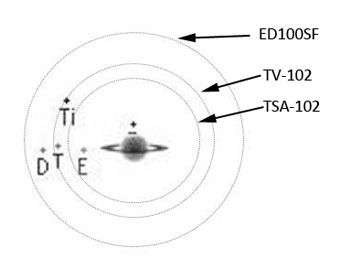 |
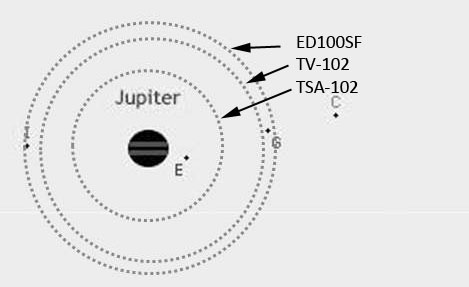 |
|---|---|
| Figure 1. Light Scatter Pattern around Saturn on July 30, 2011 about 1:00 UT for the three refractors viewed through a Pentax 5mm XO eyepiece. | Figure 2. Light Scatter Pattern around Jupiter on July 30, 2011 about 9:00 UT for the three refractors with a Pentax 5mm XO eyepiece. |
Note on light scatter patterns: Light scatter was estimated by comparing the outer border of the glare around Jupiter or Saturn relative to a bright outer moon (e.g., Titan for Saturn and usually Io for Jupiter). The amount of perceived light scatter around a bright planet is the result of several variable factors including: 1) scatter of reflected light from the planet in Earth's atmosphere due to atmospheric moisture and particulates; 2) telescopic front element and tube internal reflections and scatter; 3) diagonal reflectivity and scatter; and 3) eyepiece scatter and internal reflections. When generating the light scatter patterns for the three refractors, they were done in a period of a few minutes using the same diagonal and eyepiece so that all factors except the telescope were as constant as possible.
Jupiter:
Jupiter was observed over several days in the early morning from Gainesville, Florida. Seeing in early morning hours was generally excellent, although humidity was very high, and sky transparency was low. All three refractors provided generally good views of the Northern and Southern equatorial bands as well as Northern and Southern temperate bands and the Great Red Spot. All four major moons (Io, Europa, Callisto and Ganymede) were easily visible. It was fun watching Io transit Jupiter with any of the refractors. Band and Great Red Spot details were noticeably more easily appreciated while viewing through the TSA-102 and TV-102 than through the ED100. Views with the TSA-102 were hard to distinguish from those with the TV-102. However, after going back and forth between the two, I was convinced that slightly more detailed and subtle band and cloud patterns were visible with the TSA-102. Light scatter around the bright planet Jupiter was least when viewing with the TSA-102 and greatest when viewing with the ED100 (Figure 2).
Multiple Stars
Resolving power of the telescopes was tested on multiple stars with varying separation over several nights. Binary and multiple stars with separation of 2 or more arcseconds were easily detected as separate by all three refractors (e.g., double double in Lyra). Struve 2107 in Hercules has about 1.4 arcsecond separation and was viewed on the evening of August 6, 2011. Seeing was very good, although the sky was humid and had low transparency. The TSA-102 and Pentax 5mm XO eyepiece provided clear separation
between the two stars. With the TV-102 and 5mm Pentax eyepiece, the two stars were just barely separated. With the ED100 and 5mm Pentax eyepiece, it was possible to see that there were two stars, but they were not clearly separated.
The three refractors have variable quality and style focusers that made for different viewing experiences.
Both the TSA-102 and TV-102 have rack and pinion focusers that are easily locked. The TV-102 focuser I used was a stock unit and provided a rock-solid focusing platform. Because it only offered course focus adjustment, it took a little more skill and training to come to precise focus than with the other two focusers. The TSA-102 had a Feathertouch fine focus upgrade and was the easiest of the three focusers to use and come to precise focus consistently regardless of the load being carried by the focuser. The Vixen ED100SF has a dual speed Synta Crayford focuser that works very well under light weight diagonal and eyepiece loads. It does not work well with heavy eyepiece/binoviewer load, especially when viewing near the meridian. It slips unless locked and will not adjust focus under load.
I was successful in using a William Optics Binoviewer with all three refractors while viewing Jupiter. The TSA-102 carried the binoviewer with 8mm Plossl eyepieces and 1.6X Barlow lens in the nosepiece very well and provided wonderful binocular views of Jupiter's bands and clouds. It was possible to use the binoviewer with either a 2 inch or 1.25 inch diagonal. The binoviewer only focused with the TV-102 and ED100FS with a 1.25 diagonal. Views were excellent with the TV-102. With the ED100FS, views were degraded by light fall off and loss of contrast to the point of being less enjoyable than using a single, light weight eyepiece. Also, the binoviewer was too heavy to focus effectively with the lightweight Crayford focuser.
Conclusions
Among the three refractors that I tested, performance fell out as expected according to price.
Comment on Takahashi FS-102 - Fluorite doublet: Comparison performance between the Takahashi TSA-102 and the FS-102
Posted 08 August 2011, updated 17 August 2011, 16 September 2011